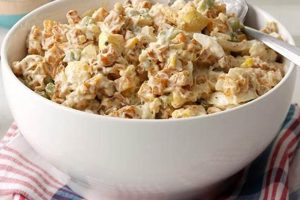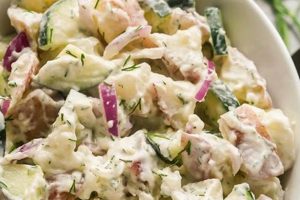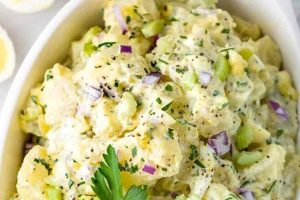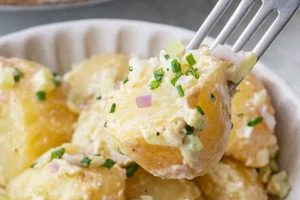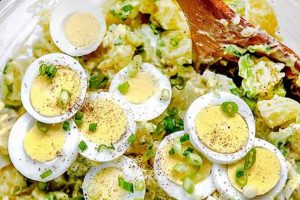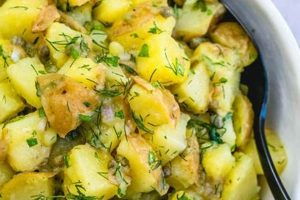A guide for preparing a cold potato salad, distinct from typical warm mashed potatoes, involves specific ingredients and procedures. This dish often features potatoes cooked until tender, then mashed and combined with mayonnaise, mustard, celery, onions, and seasonings. Variations can include hard-boiled eggs, pickles, or other additions to create unique flavor profiles.
Documentation of cold potato salads dates back centuries, adapting alongside culinary traditions and available ingredients. This dish offers a versatile and convenient meal option, suitable for picnics, potlucks, and everyday meals. Its adaptable nature allows for personalized touches, catering to diverse palates and dietary preferences. The make-ahead convenience of potato salad contributes to its popularity, particularly for gatherings and events.
The following sections will delve into detailed preparation methods, explore ingredient variations, and offer practical tips for achieving optimal results.
Tips for Perfect Mashed Potato Salad
Achieving a well-balanced and flavorful mashed potato salad requires attention to detail throughout the preparation process. The following tips offer guidance for optimal results.
Tip 1: Potato Selection and Cooking: Opt for waxy potatoes, such as Yukon Gold or red potatoes, as they hold their shape better after cooking. Avoid overcooking, as this can lead to a gummy texture. Potatoes should be tender but not mushy.
Tip 2: Cooling the Potatoes: Allow the cooked potatoes to cool completely before mashing and combining with other ingredients. This prevents the mayonnaise from melting and creating a watery salad.
Tip 3: Gentle Mashing: Over-mashing can result in a gluey consistency. Aim for a slightly chunky texture, leaving some small pieces of potato intact.
Tip 4: Mayonnaise and Seasoning Balance: Start with a moderate amount of mayonnaise and add more as needed to achieve the desired creaminess. Seasoning should be adjusted to taste, considering the saltiness of other ingredients like pickles or olives.
Tip 5: Ingredient Incorporation: Gently fold in the remaining ingredients, such as celery, onions, and hard-boiled eggs, taking care not to overmix.
Tip 6: Chilling Time: Allow the potato salad to chill for at least an hour before serving. This allows the flavors to meld and enhances the overall taste.
Tip 7: Garnish and Presentation: A simple garnish, such as chopped fresh parsley or paprika, can elevate the presentation.
By following these guidelines, one can create a delicious and satisfying mashed potato salad suitable for any occasion. Careful attention to potato selection, cooking methods, and ingredient proportions contributes to a successful outcome.
The following section offers concluding remarks and suggests potential variations for further exploration.
1. Potato Variety
Potato variety significantly influences the texture and overall success of mashed potato salad. Selecting the appropriate potato type is crucial for achieving the desired consistency and flavor profile. The following facets explore the impact of potato variety on this classic dish.
- Starchy Potatoes (Russet, Idaho)
These potatoes have a high starch content, resulting in a fluffy texture when cooked. While ideal for baking or frying, their dry, mealy consistency makes them less suitable for mashed potato salad, as they can become gummy when mashed. Their tendency to absorb liquid also affects the salad’s moisture balance.
- Waxy Potatoes (Yukon Gold, Red Bliss)
Waxy potatoes, with their lower starch content, hold their shape well after cooking and offer a creamy texture when mashed. This characteristic makes them an excellent choice for potato salad, providing a smooth, cohesive consistency without becoming gummy or overly dense. Their inherent moisture contributes to a well-balanced salad.
- All-Purpose Potatoes (White Rose, Kennebec)
These potatoes fall between starchy and waxy varieties, offering a moderate starch content. While they can be used for mashed potato salad, they may not provide the ideal creaminess of waxy potatoes or the fluffiness of starchy potatoes. Careful attention to cooking time and mashing technique is crucial for achieving a desirable result.
- New Potatoes (Small, Immature Potatoes)
New potatoes, regardless of variety, possess a thin skin and delicate texture. Their waxy nature generally lends itself well to potato salad, offering a fresh, vibrant flavor. Due to their small size, they cook quickly and require minimal peeling, contributing to a convenient preparation process.
Choosing the correct potato variety is paramount for a successful mashed potato salad. Waxy potatoes offer the best balance of texture and moisture, contributing to a smooth, creamy, and flavorful salad. While other varieties can be used, they may require adjustments in cooking and preparation techniques to achieve comparable results. Understanding the characteristics of each potato type empowers informed decision-making and contributes to a superior culinary outcome.
2. Cooking Method
The cooking method employed significantly impacts the texture, flavor, and overall quality of mashed potato salad. Selecting the appropriate technique ensures the potatoes reach the desired level of tenderness without becoming waterlogged or mushy, crucial for achieving a well-balanced final product.
- Boiling
Boiling, a common method for cooking potatoes, involves submerging them in salted water and cooking until fork-tender. This method allows for even cooking and efficient heat transfer. Overboiling, however, can lead to waterlogged potatoes, detrimental to the salad’s texture. Careful monitoring of cooking time is essential. Draining the potatoes immediately after cooking and allowing them to steam dry helps remove excess moisture.
- Steaming
Steaming offers a gentler cooking method, preserving the potatoes’ natural flavors and nutrients. Steamed potatoes retain less water than boiled potatoes, contributing to a firmer texture, ideal for mashed potato salad. This method also reduces the risk of overcooking. Specialized steaming equipment or a simple steamer basket placed over boiling water can be used effectively.
- Roasting
Roasting potatoes in the oven imparts a distinct, caramelized flavor profile and enhances their natural sweetness. While not traditionally used for mashed potato salad, roasted potatoes offer a unique twist. Their drier texture requires adjustments to the amount of binding agents and seasonings used in the salad. The resulting salad offers a richer, more complex flavor.
- Microwave Cooking
Microwave cooking offers a rapid method for preparing potatoes. While convenient, this method can result in uneven cooking and a less desirable texture compared to boiling or steaming. Microwaved potatoes tend to become mushy more easily, impacting the final consistency of the salad. This method is generally less preferred for achieving optimal results.
The chosen cooking method directly influences the final quality of mashed potato salad. While boiling remains a standard approach, steaming offers advantages in moisture control and texture preservation. Roasting introduces unique flavor profiles, while microwaving, though convenient, presents challenges in achieving optimal texture. Careful consideration of these factors contributes to a superior culinary outcome.
3. Mashing Technique
Mashing technique plays a pivotal role in determining the final texture and consistency of mashed potato salad. The degree of mashing dictates whether the salad presents a smooth, creamy consistency or a chunkier, more textured profile. Understanding the nuances of various mashing techniques allows for precise control over the final product, catering to individual preferences and recipe requirements.
- Hand Mashing with a Ricer
Utilizing a ricer yields exceptionally smooth and uniform mashed potatoes, eliminating lumps and creating a light, airy texture. This technique is particularly beneficial for achieving a refined, elegant potato salad. The ricer forces the cooked potatoes through small holes, resulting in a fine, consistent mash. This method minimizes the release of starch, preventing a gummy texture.
- Hand Mashing with a Potato Masher
A traditional potato masher offers control over the degree of mashing, allowing for a range of textures from slightly chunky to relatively smooth. This method provides a more rustic, homemade feel to the potato salad. The degree of pressure applied dictates the final consistency. This technique allows for some potato pieces to remain intact, providing textural variation.
- Electric Mixer Mashing
Electric mixers, while efficient, can overwork the potatoes, releasing excessive starch and leading to a gummy or gluey consistency. This method requires careful monitoring to avoid over-mashing. While convenient for large batches, electric mixers offer less control than hand mashing methods.
- Fork Mashing
Mashing potatoes with a fork offers a simple, readily available method for achieving a chunky, rustic texture. This technique is ideal for those seeking a less processed, more textured salad. The tines of the fork break down the potatoes while leaving larger pieces intact, providing a hearty mouthfeel.
The chosen mashing technique directly influences the final texture and mouthfeel of mashed potato salad. From the smooth elegance achieved with a ricer to the rustic heartiness of fork-mashed potatoes, each method offers distinct characteristics. Careful consideration of the desired texture informs the selection of the appropriate mashing technique, contributing significantly to the overall culinary experience.
4. Binding Agents
Binding agents play a crucial role in mashed potato salad, contributing to the desired texture and overall cohesion. These agents provide the necessary moisture and emulsification to bind the ingredients together, preventing a dry, crumbly salad. The selection and proportion of binding agents significantly impact the final product’s consistency, flavor, and stability. Understanding their function is essential for creating a successful recipe.
Mayonnaise, a common binding agent, provides a creamy texture and rich flavor. Its emulsifying properties help create a smooth, homogenous mixture. Variations exist, including low-fat or vegan mayonnaise alternatives, each impacting the salad’s nutritional profile and flavor. Sour cream offers a tangy alternative, contributing a distinct flavor dimension. Yogurt, particularly Greek yogurt, provides a lighter, protein-rich option, lending a slightly tangy note. The choice of binding agent depends on desired flavor profiles and dietary considerations. A combination of binding agents can also be employed to achieve a specific balance of flavor and texture. For example, a blend of mayonnaise and sour cream offers both richness and tanginess. Overuse of binding agents, however, can result in an excessively moist or heavy salad. Careful measurement ensures a balanced outcome.
Appropriate binding agent selection is critical for a well-balanced mashed potato salad. The agent’s properties influence not only texture and flavor but also the salad’s overall stability and shelf life. Balancing the binding agent with other ingredients, such as potatoes, vegetables, and seasonings, ensures a harmonious and palatable final product. Careful consideration of these factors allows for a tailored approach, resulting in a customized potato salad that meets specific preferences and dietary needs.
5. Flavor Enhancers
Flavor enhancers play a critical role in elevating mashed potato salad from a simple side dish to a culinary experience. These additions contribute complexity, depth, and balance, transforming the foundational ingredients into a harmonious and flavorful whole. Understanding the interplay of various flavor enhancers allows for customization and creative expression within the recipe.
Common flavor enhancers include classic aromatics like celery and onion, which provide a savory foundation. These elements offer a fresh, crisp counterpoint to the creamy potatoes. Hard-boiled eggs contribute richness and textural contrast, while pickles introduce a tangy, acidic dimension. Fresh herbs, such as dill, parsley, or chives, impart vibrant green notes and aromatic complexity. Mustard, both yellow and Dijon, adds a pungent depth and enhances the overall savoriness. Spices like paprika or celery seed offer subtle warmth and complexity. Consider incorporating smoky bacon or roasted red peppers for a deeper, more robust flavor profile. The quantity and combination of these enhancers directly influence the final character of the salad. For example, a dill-forward salad presents a distinctly different profile than one dominated by mustard and paprika.
Effective flavor enhancement requires careful balancing of ingredients. Overreliance on any single element can overshadow others, disrupting the intended harmony. A thoughtful approach considers the interplay of flavors, ensuring that each enhancer contributes to the overall composition without overpowering the other components. Regional variations often incorporate locally available ingredients, further demonstrating the adaptability and potential for customization within the basic recipe. Achieving a well-balanced and flavorful mashed potato salad requires an understanding of the individual contributions of each flavor enhancer and their synergistic effects when combined. Careful consideration of these factors allows for culinary creativity and the development of unique flavor profiles.
6. Seasoning Balance
Seasoning balance is paramount in a successful mashed potato salad recipe. It directly impacts the final flavor profile, influencing whether the dish is perceived as bland, overly salty, or harmoniously seasoned. This balance is achieved through a careful interplay of salt, pepper, and other seasonings, complementing the inherent flavors of the potatoes and other ingredients. An imbalance can detract from the overall enjoyment, rendering the salad unappetizing despite textural or visual appeal.
Consider a scenario where insufficient salt is used. The natural flavors of the potatoes and other components, such as celery or onion, may not be fully realized, resulting in a bland, underwhelming experience. Conversely, excessive salt can overpower the other flavors, creating a harsh, unpleasant taste. Achieving the right balance allows the individual flavors to shine while contributing to a unified, cohesive flavor profile. This principle applies not only to salt but also to other seasonings, such as pepper, mustard, or paprika. Their proportions relative to each other and to the overall quantity of ingredients contribute to the final flavor balance.
Practical application of this understanding requires careful tasting and adjustment throughout the preparation process. Initial seasoning of the potatoes during cooking establishes a foundational flavor base. Subsequent additions of seasonings, after the potatoes are mashed and combined with other ingredients, further refine the flavor profile. This iterative process, guided by taste, ensures a balanced outcome. Recipes provide guidelines, but individual palates and ingredient variations necessitate adjustments. Recognizing the critical role of seasoning balance elevates mashed potato salad preparation from a mechanical process to a culinary art, allowing for personalized flavor experiences.
7. Chilling Duration
Chilling duration significantly influences the final quality and flavor profile of mashed potato salad. This period of refrigeration allows the diverse flavors of the various ingredientspotatoes, vegetables, seasonings, and binding agentsto meld and harmonize. The lowered temperature also firms the salad’s texture, enhancing its structural integrity and making it easier to serve. A sufficient chilling duration is thus not merely a procedural step but a crucial element contributing to the dish’s overall success.
The impact of chilling duration becomes evident when comparing a freshly made potato salad to one that has been refrigerated for several hours. The freshly prepared salad, while palatable, may present individual flavors that are somewhat disjointed. The potatoes, celery, onions, and seasonings may each retain distinct identities rather than presenting a cohesive flavor profile. After chilling, however, these individual flavors harmonize, creating a unified and more complex taste experience. The chilling process also allows the potatoes to absorb the flavors of the seasonings and binding agents more fully, further enhancing the overall taste and texture.
Practical implications of this understanding include improved planning for gatherings and events. Preparing the potato salad a day or two in advance and allowing ample chilling time ensures optimal flavor development and texture. Furthermore, understanding the influence of chilling duration allows for adjustments based on specific circumstances. For instance, a warmer ambient temperature may necessitate a longer chilling period to achieve the desired firmness and flavor melding. Conversely, a shorter chilling duration may suffice in cooler environments. This knowledge empowers informed decision-making and contributes to consistent, high-quality results, solidifying the importance of chilling duration as a critical component of a successful mashed potato salad recipe.
Frequently Asked Questions
This section addresses common inquiries regarding mashed potato salad preparation, offering practical guidance and clarifying potential points of confusion. A comprehensive understanding of these aspects contributes to a successful culinary outcome.
Question 1: What type of potato is best suited for mashed potato salad?
Waxy potatoes, such as Yukon Gold or Red Bliss, are recommended. Their lower starch content prevents a gummy texture, resulting in a smoother, creamier salad.
Question 2: Can the potatoes be overcooked?
Overcooking results in a mushy texture, detrimental to the salad’s overall quality. Aim for tender yet firm potatoes that hold their shape when mashed.
Question 3: What is the ideal chilling time for mashed potato salad?
Chilling for at least two hours, preferably longer, allows flavors to meld and enhances the salad’s texture. Overnight chilling is often ideal.
Question 4: How can one prevent a watery potato salad?
Ensure potatoes are thoroughly drained after cooking and cooled completely before combining with other ingredients, particularly mayonnaise-based dressings.
Question 5: What are common flavor enhancers for mashed potato salad?
Common additions include celery, onion, hard-boiled eggs, pickles, fresh herbs (dill, parsley, chives), mustard, and spices like paprika or celery seed.
Question 6: Can alternative binding agents be used instead of mayonnaise?
Alternatives include sour cream, plain yogurt (especially Greek yogurt), or a combination thereof. These options offer variations in flavor and texture profiles.
Careful consideration of these frequently asked questions ensures a successful and enjoyable mashed potato salad experience. Understanding the nuances of potato selection, cooking methods, and flavor balancing empowers informed decision-making and contributes to a superior culinary outcome.
The following section offers concluding remarks and suggests potential variations for further exploration.
Conclusion
Exploration of the elements comprising a successful mashed potato salad recipe reveals the critical interplay of ingredients, techniques, and flavor balancing. Careful potato selection, employing appropriate cooking methods, and understanding the impact of mashing techniques contribute significantly to the desired textural outcome. The judicious use of binding agents and flavor enhancers, coupled with precise seasoning, elevates this seemingly simple dish to a culinary expression. Chilling duration further amplifies the melding of flavors, culminating in a harmonious and satisfying sensory experience.
Culinary traditions often adapt and evolve, reflecting cultural influences and ingredient availability. Continued exploration of variations within the foundational elements of mashed potato salad recipes offers opportunities for personalized interpretations and culinary innovation. Understanding the underlying principles governing ingredient interactions and flavor profiles empowers informed experimentation and the creation of unique culinary experiences.

